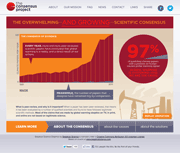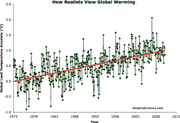Chaos theory and global warming: can climate be predicted?
What the science says...
| Select a level... |
 Basic
Basic
|
 Intermediate
Intermediate
| |||
|
Weather is chaotic but climate is driven by Earth's energy imbalance, which is more predictable. |
|||||
Climate is chaotic and cannot be predicted
'Lorenz (1963), in the landmark paper that founded chaos theory, said that because the climate is a mathematically-chaotic object (a point which the UN's climate panel admits), accurate long-term prediction of the future evolution of the climate is not possible "by any method". At present, climate forecasts even as little as six weeks ahead can be diametrically the opposite of what actually occurs, even if the forecasts are limited to a small region of the planet.' (Christopher Monckton)
One of the defining traits of a chaotic system is 'sensitive dependence to initial conditions'. This means that even very small changes in the state of the system can quickly and radically change the way that the system develops over time. Edward Lorenz's landmark 1963 paper demonstrated this behavior in a simulation of fluid turbulence, and ended hopes for long-term weather forecasting.
However, climate is not weather, and modeling is not forecasting.
Although it is generally not possible to predict a specific future state of a chaotic system (there is no telling what temperature it will be in Oregon on December 21 2012), it is still possible to make statistical claims about the behavior of the system as a whole (it is very likely that Oregon's December 2012 temperatures will be colder than its July 2012 temperatures). There are chaotic components to the climate system, such as El Nino and fluid turbulence, but they all have much less long-term influence than the greenhouse effect. It's a little like an airplane flying through stormy weather: It may be buffeted around from moment to moment, but it can still move from one airport to another.
Nor do climate models generally produce weather forecasts. Models often run a simulation multiple times with different starting conditions, and the ensemble of results are examined for common properties (one example: Easterling & Wehner 2009). This is, incidentally, a technique used by mathematicians to study the Lorenz functions.
The chaotic nature of turbulence is no real obstacle to climate modeling, and it does not negate the existence or attribution of climate change.
Last updated on 8 September 2010 by chuckbot. View Archives































 Arguments
Arguments































Climate Myth...